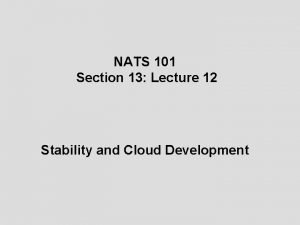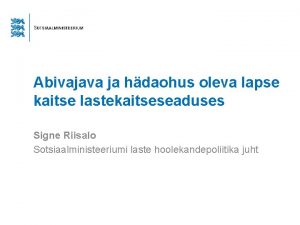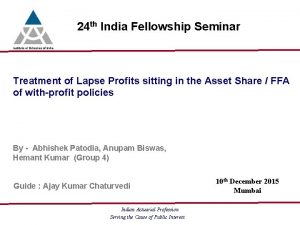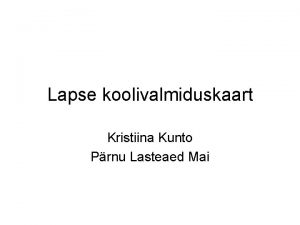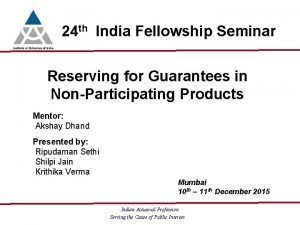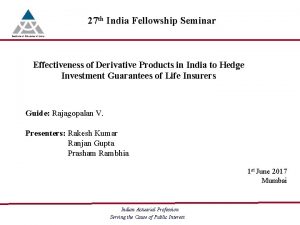24 th India Fellowship Seminar Treatment of Lapse


















- Slides: 18

24 th India Fellowship Seminar Treatment of Lapse Profits sitting in the Asset Share / FFA of with-profit policies By - Abhishek Patodia, Anupam Biswas, Hemant Kumar (Group 4) Guide : Ajay Kumar Chaturvedi Indian Actuarial Profession Serving the Cause of Public Interest 10 th December 2015 Mumbai

Agenda • Introduction • Treatment of Lapse profit • Professional & Regulatory Framework • Market Practice • Summary & Conclusion www. actuariesindia. org 2

Introduction – Important definitions What is With-Profit (Par) contract: Contracts which participates in the surplus (profits) during the term of the policy. IRDAI (Actuarial Report and Abstract) Regulations, 2000 defines par policies as “policies with participation in profits” means policies which are not non-par policies” as defined under the relevant clause of the regulation. Defining Asset Share: Accumulation of: Premium plus Investment Income Benefit Outgo plus Commission plus Expense plus Tax plus SH Transfer plus COC & COG plus Misc GN 6 definition: “An asset share for a policy grouping at a given point in time is the accumulation of the premiums received plus investment income earned from the inception of the policies, less deductions due to benefit payments, commission, expenses, tax, a reasonable cost of capital and of guarantees, contribution from miscellaneous surplus (if considered appropriate) and transfers to shareholders”. The above definition doesn’t explicitly capture surrender profit, hence it may be deemed that its treatment is open for interpretation. www. actuariesindia. org 3

Introduction – Important definitions Defining FFA: For with-profit contracts FFA is also commonly known as Estate IRDAI (Preparation of Financial Statements and Auditor’s Report of Insurance Companies) Regulations, 2002 defines FFA as “The FFA shall represent all funds, the allocation of which, either to the policyholders or to the shareholders, has not been determined by the end of the financial year”. Estate in a par fund represents the undistributed surplus in with-profit fund. Regulatory Consideration in Distribution of Surplus (Profit): Distribution of surplus for life insurance companies in India is governed by IRDAI (Distribution of Surplus) Regulations, 2002. Section 4(b) of the Regulation prescribes the maximum allocation to shareholders to the extent of “one-ninth of the surplus allocated to policyholders in case of a life fund maintained for participating policyholders” www. actuariesindia. org 4

Introduction - Lapse as a source of Surplus (Profit) Typical Sources of surplus (profit): • Bonus loading • Investment return • Expenses • Mortality • Lapse (termination) • Surplus from other contracts (if any) • One-off or miscellaneous What is Lapse Profit? Lapse profit can be defined as Asset Share of a policy less the benefit paid to policyholder upon termination by lapse or surrender. How Lapse Profit arises? Companies generally pay lesser than the earned asset share of the policy, because: • Asset Share calculation is a recent phenomena • Intentional – to protect the insurer against adverse market movement Lapse profit primarily arises due to • poor customer retention • practical challenges of having to calculate the asset share frequently at a policy level, www. actuariesindia. org 5

Possible Approaches of Lapse Profit Allocation Possible Approaches Credited to Asset share Cash flow addition to Asset Share Credited to FFA/Estate Addition via investment return www. actuariesindia. org Approaches: • Credited to Asset Share - Cash flow method - via Investment Return • Credited to Estate / FFA 6

Considerations - Credit to Asset Share Which policyholders? Same cohort or all remaining policyholders? Regard to Policyholders’ Reasonable Expectation (PRE) and past practices Uncertain nature of Lapse Profit Bonus Philosophy of the company – Form and Method of distribution of surplus Competitive consideration Communication to Policyholders in the form of Benefit Illustration and/or Customer friendly PPFM Administrative and system readiness www. actuariesindia. org 7

1. Regulatory Capital Support 2. Provides investment freedom 3. Absorbing expense overrun of the par fund to the extent not charged to Asset Share Consideration Reasons for crediting to FFA Considerations - Credited to FFA / Estate 1. Past practice and PRE 2. Solvency Ratio 3. Reattribution of estate Eventually all/part of lapse profit will flow to asset share…. www. actuariesindia. org 8

Professional Consideration - APS 1 Appointed Actuary must ensure the following: • business in conducted on sound financial lines • ratio of ASM to RSM is reasonable On PRE On Surplus www. actuariesindia. org • he/she has regards to PRE • appropriate and equitable treatment of the policyholders • company appreciates the implication of any big change on PRE • new policyholders are not mislead with respect to their expectation • advise the company on surplus distribution • ensure compliance with Section 49 of the Act • advise the company whether PRE is met or not and the distribution is sustainable or not 9

Professional Consideration – GN 6 Appointed Actuary must consider the following: • grouping of policies for determination of asset share and bonus • such grouping should not materially advantage one group of policyholders at expense of another Treatment of surrender surplus Addition to Asset Share • Whether and to what extent surrender surpluses are being used to support the payouts to policyholders who hold their policies for longer. • Appointed Actuary should consider if the method of surplus distribution, either reversionary or terminal bonus, is well-matched to the source of surplus. • Where the asset share is to include the impact of surrender profits, the Appointed Actuary should consider whether to explicitly or implicitly (for example by artificially adjusting the investment return) allow for the surrender profits when carrying out the calculations. • Approach adopted is fair and appropriate and that a consistent method is adopted from year to year. Appointed Actuary should document the company’s approach to and treatment of each of the items of surplus or deficit www. actuariesindia. org 10

Regulatory consideration - Insurance Regulatory and Development Authority (Non-Linked Insurance Products) Regulations, 2013 Relevant Sections • 35 (i) The special surrender value shall represent the asset share in case of the par policies, where the asset share shall be determined in accordance with the guidance or practice standards issued by the Institute of Actuaries of India. • 45 (c) The detailed working of the asset share, the expensed allowed for, the investment income earned on the fund etc which are represented in the asset share shall be approved by a with profits committee. Increasing governance framework around par business – may reduce the surrender surplus in future – increasing persistency is the key www. actuariesindia. org 11

Suitable Approach? Is one approach more suitable than another? • Even if lapse profit is transferred to estate it may benefit policyholder in the form of higher investment return through greater investment flexibility, enhanced protection in terms of higher solvency margin etc. • Estate may ultimately get transferred to the policyholders in form of bonuses (one off or regular) than supported by Asset Shares Benefit Illustration does not communicate asset share directly but implicitly yes through bonus rates. There is no stopping from payment of say TB through transfer from estate. It may also depend on how increased per policy expenses are recouped? – Reference to GN 6 and APS 5 • Charging to asset share • via estate Mixed practices observed in India • by shareholders www. actuariesindia. org 12

What’s the practice in Indian market? Indian Par Business – Share $ Share of par business grew from ~40% in 2010 to ~80% in 2014 • Spurt in Par Business – a Recent phenomena Allocation of Surrender Profits 31% # 69% Credited to Assete Share Why this pattern is emerging? • Calculation of Asset Shares – a recent phenomena. So challenges in allocation of profits and expenses • Evolving market - Building up of the Estate • New Companies-Expense overruns • Similar trend in allocation of other miscellaneous profits Credited to the Estate www. actuariesindia. org $ Participating Business: Towards better governance and transparency by Milliman – 28 November 2014 # India Asset Share Survey by Milliman – 04 February 2014 13

What’s the practice in Indian market? Indian Market Industry in Nascent Stage - Industry opened up only 15 years back. Industry started focusing on with profits business only in last 5 years Emergence of lapse profit is highly uncertain. Distributing it through regular bonuses may lead to unwarranted PRE. A large proportion of insurers do not set the maximum deviation amount of maturity or surrender payments from Asset Share Overall Trend – Asset share is not the sole criteria to set bonus and surrender values. Lapse Profits are held back to build up estate. www. actuariesindia. org 14

What’s the practice in UK market? PPFM – A mandatory document for With Profits Business • • Covers Treatment of Surrender Profits and other miscellaneous profits Decision on the advice of With Profits Actuary and With Profit Committee Trend - Declining share of with profits business • ~40% of new business in mid 80 s to less than 10% in this decade • Investment Freedom of the UK insurance companies have a contracting fund size • Most Smoothing Flexibility • Hence treatment of estate and lapse profit sitting in it is an important issue www. actuariesindia. org 15

What’s the practice in UK market? UK Market If the Company has a Stable With Profit Business Profits from Surrenders are credited to the estate until credited back to the Asset Share but maintaining a sound Estate Asset Share in excess of the sum assured annual bonuses paid is distributed through final bonus – Subject to: • Smoothing and • Financial condition of the fund www. actuariesindia. org If the Company has a Shrinking Fund Declining with profits business Estate size is greater than is required for shrinking size of the funds Reattribution of the estate Policyholders are offered cash bonuses in return for giving up their right to future distributions from the relevant estate 16

Summary & conclusion • We have detailed regulations on Par business, Calculation of Asset Share and distribution of profits between policyholders and shareholders • Indian Par Business – On a growth trajectory in recent past • Majority of the companies have started calculating Asset share only recently • Imbibe learnings from UK market. Cautious approach is required for treatment of Lapse Profits sitting in the estate. A prudent approach is required to distribute these profits in order to avoid building up of PRE. • Emergence of Lapse Profits are highly uncertain. Distribution of Lapse Profits through regular bonuses may lead to unwarranted PRE. • Eventually all lapse profits, presently being credited majorly to the Estate should flow back to the policyholder through attribution to Asset Share. To enable the above • Strengthen governance – similar to PPFM • Periodic review of scope and functioning of With Profits Committee www. actuariesindia. org 17

Time for discussion www. actuariesindia. org 18
 Seminar on education in india
Seminar on education in india The phrase “quantum meruit” literally means –
The phrase “quantum meruit” literally means – Absolutely unstable air
Absolutely unstable air Adiabatic lapse rate
Adiabatic lapse rate Lapse heaolu kolmnurk
Lapse heaolu kolmnurk Unstable lapse rate
Unstable lapse rate Vertical motion
Vertical motion Bepin choudhury lapse of memory summary
Bepin choudhury lapse of memory summary Nys dmv insurance lapse phone number
Nys dmv insurance lapse phone number Lapse rate equation
Lapse rate equation International neuropsychoanalysis society
International neuropsychoanalysis society Doctrine of lapse
Doctrine of lapse Perbedaan ethical dilemma dan ethical lapse
Perbedaan ethical dilemma dan ethical lapse Raputatud lapse sündroom
Raputatud lapse sündroom Perbedaan ethical dilemma dan ethical lapse
Perbedaan ethical dilemma dan ethical lapse Lapse rate
Lapse rate Absolutely unstable air
Absolutely unstable air Saturated adiabatic lapse rate
Saturated adiabatic lapse rate Secdef executive fellowship
Secdef executive fellowship



